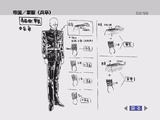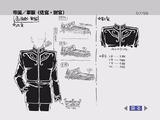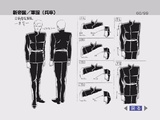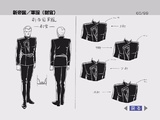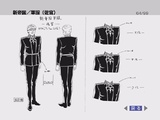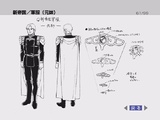Military ranks of the Galactic Empire
From Gineipaedia, the Legend of Galactic Heroes wiki
The military ranks of the Galactic Empire were a system of hierarchical titles used to indicate position and stature within the Imperial military. One ranking system applied to both space and ground forces, and ground forces were considered the more junior arm of the military due to the dominance of space warfare. Officers could serve in both branches but there existed a minority that specialised purely in ground combat and boarding actions.
Ranks
Spaceman Second Class
The insignia of a spaceman second class (Japanese: 二等兵 nitōhei) consisted of epaulettes with no bars on the shoulders and no stripes on the cuffs of their sleeves. This was the starting rank for conscripts serving their 2 years of mandatory military service upon reaching the age of 20. (HBSHBL: 'Candidate for Succeeding a Count's Family')
Spaceman First Class
The insignia of a spaceman first class (Japanese: 一等兵 ittōhei) consisted of epaulettes with no bars on the shoulders and one stripe on the cuffs of their sleeves. Conscripts serving their 2 years of mandatory military service upon reaching the age of 20 would be promoted to this rank after surviving one year of service. (HBSHBL: 'Candidate for Succeeding a Count's Family')
Able Spaceman
The insignia of an able spaceman (Japanese: 上等兵 jōtōhei) consisted of epaulettes with no bars on the shoulders and two stripes on the cuffs of their sleeves.
Leading Spaceman
The insignia of a leading spaceman (Japanese: 伍長 gochō) consisted of epaulettes with no bars on the shoulders and three stripes on the cuffs of their sleeves.
Petty Officer Second Class
The insignia of a petty officer second class (Japanese: 軍曹 gunsō) consisted of epaulettes with one bar on the shoulders and three stripes on the cuffs of their sleeves.
Petty Officer First Class
The insignia of a petty officer first class (Japanese: 曹長 sōchō) consisted of epaulettes with one bar on the shoulders and two stripes on the cuffs of their sleeves.
Warrant Officer
The insignia of a warrant officer (Japanese: 准尉 jun'i) consisted of separate epaulettes and chest plates with a cane shaped flourish, with no bars on the end of each shoulder. Graduates of the officer academy typically received this rank when they began their service.
Ensign
The insignia of an ensign (Japanese: 少尉 shōi) consisted of separate epaulettes and chest plates with a cane shaped flourish, with one bar on the end of each shoulder.
Sub-lieutenant
The insignia of a sub-lieutenant (lieutenant junior grade) (Japanese: 中尉 chūi) consisted of separate epaulettes and chest plates with a cane shaped flourish, with two bars at the end of each shoulder.
Lieutenant
The insignia of a lieutenant (Japanese: 大尉 taii) consisted of separate epaulettes and chest plates with a cane shaped flourish, with three bars on the end of each shoulder.
Lieutenant commander
The insignia of a lieutenant commander (Japanese: 少佐 shōsa) consisted of separate epaulettes and chest plates with a W-shaped flourish, with one bar on the end of each shoulder.
Examples: Lieutenant Commander Bernhard von Schneider, (pre-Neue Reich, FPA)
Commander
The insignia of a commander (Japanese: 中佐 chūsa) consisted of separate epaulettes and chest plates with a W-shaped flourish, with two bars on the end of each shoulder epaulette.
Captain
The insignia of a captain (Japanese: 大佐 taisa) consisted of separate epaulettes and chest plates with a W-shaped flourish, with three bars on the end of each shoulder epaulette. A captain could command an individual flagship or battleship.
Examples: Captain Hans Eduard Bergengrün, (pre-Neue Reich and Neue Reich)
Commodore
The insignia of a commodore (Japanese: 准将 junshō) consisted of unified epaulettes and chest plates, with no bars on the shoulders. Imperial commodores could command a a small squadron of ships of around 400 vessels (or less) that formed part of a larger Vice Admiral's named fleet. They could also serve in imperial staff positions and in ground forces like the imperial armored grenadiers.
Example: Commodore Ansbach, (Lippstadt League)
Rear admiral
The insignia of a rear admiral (Japanese: 少将 shōshō) consisted of unified epaulettes and chest plates, with one bar on the end of each shoulder. Imperial rear admirals could command a a fleet of around 2,000 vessels that formed part of a larger Vice Admiral's named fleet. They could also serve in Imperial staff positions and ground forces.
Examples: Rear Admiral Oskar von Reuenthal, (pre-Neue Reich and Neue Reich) Rear Admiral Anton Fellner, (pre-Neue Reich and Neue Reich) Rear Admiral Fusseneger, (pre-Neue Reich) Rear Admiral Karl Edward Bayerlein (Neue Reich, later promoted to full Admiral)
Vice admiral
The insignia of a vice admiral (Japanese: 中将 chūjō) consisted of unified epaulettes and chest plates, with two bars on the end of each shoulder. Imperial vice admirals could command a a fleet of around 10,000 to 12,000 vessels that is identified by its admiral's last name. They could also serve in Imperial high staff positions and ground forces.
Examples: Vice Admiral Flegel, (Lippstadt League) Vice Admiral Erlache, (pre-Neue Reich) Vice Admiral Arthur von Streit, (pre-Neue Reich)
Admiral
The insignia of an admiral (Japanese: 大将 taishō) consisted of unified epaulettes and chest plates, with three bars on the end of each shoulder. Imperial Admirals command a a large fleet of around 13,000 to 17,000 vessels that is identified by its admiral's last name. They could also serve in Imperial high staff positions and ground forces. Examples:
Examples: Admiral Alfred Grillparzer, (pre-Neue Reich and Neue Reich) Admiral Karl Gustav Kempff, (pre-Neue Reich) Admiral Staden, (Lippstadt League)
High admiral
The insignia of a high admiral (Japanese: 上級大将 jōkyū taishō) consisted of unified epaulettes and chest plates, with three bars on the end of each shoulder, plus a flourished diagonal bar on either side of the neck. Imperial High Admirals could command a large fleet of around 20,000 to 30,000 vessels that was identified by its admiral's last name. They could also serve as departments heads in the Imperial high staff and ground forces. High Admirals would also serve as a campaign and theater overall commander.
This was the highest rank that a pure ground force commander could reach, and such a commander would have had command of all ground forces in the Empire. (HBSHBL: 'The Hard Wind of Early Summer')
Examples: High Admiral Ernst von Eisenach (Neue Reich) High Admiral Fritz Josef Bittenfeld (Neue Reich) High Admiral Wilhelm von Littenheim (Lippstadt League) High Admiral Willibald Joachim von Merkatz, (pre-Neue Reich, Free Planets Alliance)
Fleet admiral
The insignia of a fleet admiral (Japanese: 元帥 gensui) consisted of unified epaulettes and chest plates, with three bars on the end of each shoulder, plus a flourished diagonal bar on either side of the neck plus a cloak and additional gold shoulder epaulettes.
Imperial Fleet Admirals command the Empire's different staff department post like the Chief of Staff, the Minister of Military Affairs, the Chief Fleet Commander and the Deputy Chief Fleet Commander. Fleet Admirals would also serve as a campaign and theater overall commander.
Examples: Fleet Admiral Oskar von Reuenthal (Neue Reich) Fleet Admiral Otho von Braunschweig (Lippstadt League) Fleet Admiral Ehrenberg (pre-Neue Reich)
